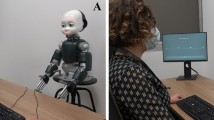Abstract
Trust is a critical factor in the development and maintenance of effective human-autonomy teams. As such, new processes are needed to classify affective state change that could be related to either an accurate or a misaligned change in trust that occurs during collaboration. The task for the current study was a leader-follower, simulated driving task with two different types of driving autonomy, and two different levels of reliability. Facial expression was evaluated to gauge group differences in affect-based trust. Results indicated that the participant sample was best described by four distinct group clusters who varied in their level of subjective trust and facial expressivity.
Access this chapter
Tax calculation will be finalised at checkout
Purchases are for personal use only
Similar content being viewed by others
References
Schaefer, K.E.: Measuring trust in human robot interactions: development of the Trust Perception Scale – HRI. In: Lawless, W., Mittu, R., Wagner, A., Sofge, D. (eds.) The Intersection of Robust Intelligence (RI) and Trust in Autonomous Systems. Springer, pp. 191–218 (2012)
Freedy, A., de Visser, E., Weltman, G., Coeyman, N.: Measurement of trust in human-robot collaboration. In: Proceedings of the 2007 International Conference on Collaborative Technologies and Systems, pp. 106–114. IEEE, Orlando (2007)
Marathe, A., Metcalfe, J., Lance, B.J., Lukos, J., Jangraw, D.C., Lai, K.T., Touryan, J., Stump, E., Sadler, B.M., Nothwang, W., McDowell, K.: The privileged sensing framework: a principled approach to improved human-autonomy integration. Theor. Issues Ergonomics Sci. 19, 283–320 (2018)
Dong, Y., Hu, Z., Uchimura, K., Murayama, N.: Driver inattention monitoring system for intelligent vehicles: a review. IEEE Trans. Intell. Transp. Syst. 12, 596–614 (2011)
Nass, C., Jonsson, I-M., Harris, H., Reaves, B., Endo, J., Brace, S., Takayama, L.: Improving automotive safety by pairing driver emotion and car voice emotion. In: International Conference on HCI (2005)
Lisetti, C.L., Nasoz, F.: Affective intelligent car interfaces with emotion recognition. In: 11th International Conference on HCI (2005)
Neubauer, C., Matthews, G., Saxby, D.J.: The effects of cell phone use and automation on driver performance and subjective state in simulated driving. In: Proceedings of the 56th Annual HFES, Boston, Massachusetts (2012)
Neubauer, C., Matthews, G., Saxby, D.J.: Fatigue in the automated vehicle: Do games and conversation distract or energize the driver? In: Proceedings of the 57th Annual HFES, Chicago, Illinois (2014)
Sarter, N.B., Woods, D.D., Billings, C.E.: Automation surprises. In: Handbook of HFES, 2 edn., pp. 1926–1943 (1997)
Gu, H., Ji, Q.: An automated face reader for fatigue detection. In: FGR, pp. 111–116 (2004)
Zhang, Z., Zhang, J.: Driver fatigue detection based intelligent vehicle control. In: ICPR 2006: Proceedings of the 18th International Conference on Pattern Recognition, Washington, DC (2006)
Metcalfe, J.S., et al.: Building a framework to manage trust in automation. In: Proceedings of SPIE 10194, Micro- and Nanotechnology Sensors, Systems, and Applications IX (2017)
John, O.P., Donahue, E.M., Kentle, R.L.: The Big Five Inventory-Versions 4a and 54. University of California, Berkeley, Institute of Personality and Social Research, Berkeley (1991)
Greco, V., Roger, D.: Coping with uncertainty: the construction and validation of a new measure. J. Personality Individ. Differ. 3, 519–534 (2001)
Muir, B.M., Moray, N.: Trust in automation Part II. Experimental studies of trust and human intervention in a process control simulation. Ergonomics 39, 429–460 (1996)
Jian, J.Y., Bisantz, A.M., Drury, C.G.: Towards an empirically determined scale of trust in computerized systems: distinguishing concepts and types of trust. In: Proceedings of the 42nd Annual Meeting of the HFES, Chicago, IL (1998)
Hart, S.G., Staveland, L.E.: Development of NASA-TLX (Task Load Index): Results of empirical and theoretical research. In: Hancock, P.A., Meshkati, N. (eds.) Human Mental Workload, Amsterdam, North-Holland, pp. 239–250 (1988)
Baltrušaitis, T., Zadeh, A., Chong Lim, Y., Morency, L.P.: OpenFace 2.0: Facial Behavior Analysis Toolkit. In: IEEE International Conference on Automatic Face and Gesture Recognition (2018)
Ekman, P., Friesen, W.: Facial Action Coding System: A Technique for the Measurement of Facial Movement. Consulting Psychologists Press, Palo Alto (1978)
Perelman, B.S., Dorton, S., Harper, S.: Identifying consensus in heterogeneous multidisciplinary professional teams. In: Proceedings of the 2019 IEEE Conference on Cognitive and Computational Aspects of Situation Management (CogSIMA), Las Vegas, NV (2019)
Gruen, B., Leisch, F.: Fitting finite mixture of generalized linear regressions in R. Computat. Stat. Data Anal. 51, 5247–5252 (2007)
Acknowledgement
This research was supported by the Office of the Secretary of Defense through the Autonomy Research Pilot Initiative under MIPR DWAM31168. The views and conclusions of this document are those of the authors and should not be interpreted as representing the official policies, either expressed or implied, of the CCDC Army Research Laboratory or US Government. The US Government is authorized to reproduce and distribute reprints for Government purposes notwithstanding any copyright notation herein.
Author information
Authors and Affiliations
Corresponding author
Editor information
Editors and Affiliations
Rights and permissions
Copyright information
© 2020 Springer Nature Switzerland AG
About this paper
Cite this paper
Neubauer, C., Gremillion, G., Perelman, B.S., La Fleur, C., Metcalfe, J.S., Schaefer, K.E. (2020). Analysis of Facial Expressions Explain Affective State and Trust-Based Decisions During Interaction with Autonomy. In: Ahram, T., Karwowski, W., Vergnano, A., Leali, F., Taiar, R. (eds) Intelligent Human Systems Integration 2020. IHSI 2020. Advances in Intelligent Systems and Computing, vol 1131. Springer, Cham. https://doi.org/10.1007/978-3-030-39512-4_152
Download citation
DOI: https://doi.org/10.1007/978-3-030-39512-4_152
Published:
Publisher Name: Springer, Cham
Print ISBN: 978-3-030-39511-7
Online ISBN: 978-3-030-39512-4
eBook Packages: Intelligent Technologies and RoboticsIntelligent Technologies and Robotics (R0)




